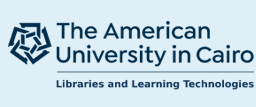-

Is there a computational advantage to representing evaporation rate in ant colony optimization as a gaussian random variable?
Ashraf M. Abdelbar
We propose an ACO (Ant Colony Optimization) variation in which the evaporation rate, instead of being constant as is common in standard ACO algorithms, is a Gaussian random variable with non-negligible variance. In experimental results in the context of MAX-MIN Ant System (MMAS) and the Traveling Salesman Problem (TSP), we find that our variation performs considerably better than MMAS when the number of iterations is small, and that its performance is slightly better than MMAS when the number of iterations is large. © 2012 ACM.
-

Modeling the response of Bang-Bang digital PLLs to phase error perturbations
Moataz Abdelfattah, Maged Ghoneima, Yehea I. Ismail, Amr Lotfy, and Mohamed Abdel-Moneum
[abstract not available]
-

A novel digital loop filter architecture for bang-bang ADPLL
Moataz Abdelfattah, Maged Ghoneima, Yehea I. Ismail, Amr Lotfy, and Mohamed Abdelsalam
[abstract not available]
-

Efficient sensitivity analysis of optical structures using finite element method
Mohamed R. Abdelhafez and Mohamed A. Swillam
[abstract not available]
-

On the effect of interference on Wi-Fi-based wireless networked control systems
E. E. Abdel Reheem, Y. I. El Faramawy, H. H. Halawa, M. A. Ibrahim, and A. Elhamy
[abstract not available]
-

A new sensor distribution for different applications and lifetime elongation techniques
M. Abdelsalam, N. A. Ali, H. M. El-Sayed, H. H. Amer, and R. M. Daoud
[abstract not available]
-

DC testing of switched capacitor based delta sigma converters
O. S. Ahmed, M. B. Abdelhalim, A. H. Madian, and H. H. Amer
[abstract not available]
-

Efficient sensitivity analysis of photonic structures with transmission line modeling
Osman S. Ahmed, Mohamed H. Bakr, Mohamed A. Swillam, and Xun Li
[abstract not available]
-

A local-diffusion genetic algorithm for disjoint pareto-optimal problems with application to vehicle suspension
Mohamed F. Aly, Ashraf O. Nassef, and Karim Hamza
[abstract not available]
-

Schematic-driven physical verification: Fully automated solution for analog IC design
Ahmed Arafa, Hend Wagieh, Rami Fathy, John Ferguson, and Doug Morgan
[abstract not available]
-

Role of processes in electronic government (case of Egypt)
Nahed Azab
This paper highlights the importance of processes in any egovernment program by introducing the main areas of change in them. It investigates focal e-government processes through conducting a research on four organizations presenting Egyptian public organizations. Results revealed that determination of motives of business processes' change and documenting such changes proved to be the most important factors in in the processes to be carried out in an e-government project. Findings highlighted also a lack of internal integration of business processes in three of the four organizations studied due to the absence of Intranet or to the unwillingness to use an existing one. Also, business process integration among governmental organizations is still in an early stage and requires further improvements. Finally, processes undertaken in evaluating citizens' usage of each agency's website are highly considered and analyzed.
-

Effective technique for the recognition of writer independent off-line handwritten Arabic words
Sherif Abdel Azeem and Hany Ahmed
[abstract not available]
-

Online Arabic handwritten digits recognition
Sherif Abdel Azeem, Maha El Meseery, and Hany Ahmed
[abstract not available]
-

Integrated software tools for the memory management of low-energy embedded signal processing systems
Florin Balasa and Dhiraj K. Pradhan
[abstract not available]
-

Impact of applying electrocoagulation pre-treatment step on grey water treatment by submerged membrane bioreactor
Khalid Bani-Melhem and Edward Smith
[abstract not available]
-

Automatic pseudo-random regression testing for GUI-centric embedded software
Mai Daftedar and Mohamed Shalan
[abstract not available]
-

Brick masonry and sustainable construction
Islam El-Adaway, Tamer Breakah, and Safwan Khedr
[abstract not available]
-

A mixture of two gender classification experts
Yomna Safaa El-Din, Mohamed N. Moustafa, and Hani Mahdi
[abstract not available]
-

Measurements of hub flow interaction on film cooled nozzle guide vane in transonic annular cascade
Lamyaa A. El-Gabry, Ranjan Saha, Jens Fridh, and Torsten Fransson
[abstract not available]
-

Modeling and experimental verification of electromagnetic energy harvesting from plate structures
Mohamed M.R. El-Hebeary, Mustafa H. Arafa, and Said M. Megahed
[abstract not available]
-

Design methodology for square wave resonant clock generators
Mohamed W. El Mahalawy and Yehea Ismail
[abstract not available]
-

Integrated optimization of a solar-powered humidificationdehumidification desalination system for small communities
Mohamed El-Morsi, Karim Hamza, Ashraf O. Nassef, Sayed Metwalli, and Kazuhiro Saitou
[abstract not available]
-

Computational fluid dynamics simulation of a thermoacoustic refrigerator
Ahmed I.Abd El-Rahman and Ehab Abdel-Rahman
[abstract not available]
-

Influence of flax fibers on properties of starch-based composites
Hamdy Elsayed, Mahmoud Farag, Hassan Megahed, and Sherif Mehanny
[abstract not available]
Printing is not supported at the primary Gallery Thumbnail page. Please first navigate to a specific Image before printing.

